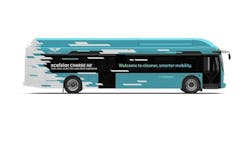Schneider and partners to pilot unusual EV microgrid in Oakland, California
As electric vehicles (EVs) and microgrids each grow in market share, their paths are intertwining, offering a vision of how together they will change power delivery. An example is a pilot project for a California library announced this week by Schneider Electric and several partners.
It’s nothing new for microgrids to include EV charging stations. But it is unusual for microgrids to use charged EVs as energy resources — as power sources. Even more unusual is the use of hydrogen-electric buses. The Oakland Public Library project intends to do both.
With $3.2 million in funding from the California Energy Commission, the project will demonstrate the value of bidirectional electric vehicle charging to make what project partners call a vehicle-to-building (V2B) resilience hub at the library.
Owned and operated by AC Transit, the electric buses will store and discharge electricity to power filtered air conditioning and critical services at the West Oakland branch of the Oakland Public Library.
Local residents will be able to use the library as a “safe haven” when it’s hot or wildfires are making the outdoor air unhealthy to breathe, said Jana Gerber, president of microgrids North America at Schneider Electric, which will provide the microgrid control and switchgear technology.
The project also will demonstrate how different technologies can integrate to seamlessly and intelligently create crucial backup power for the community and infrastructure, according to Gerber.
Like all microgrids, the system will be able to island from the utility grid during a power outage and provide electricity to the building’s critical loads. The microgrid is being designed to include about 300 kW of solar generation.
The project partners plan to start with battery electric buses. Later, they will incorporate the hydrogen fuel cell electric buses with the help of New Flyer, a subsidiary of NFI Group.
The battery electric buses will provide up to six hours of backup power, while the hydrogen buses will offer 11 hours.
The project marks the first time a US transit agency will use a hydrogen vehicle for V2B backup power, according to the partners. Paul Soubry, NFI president and CEO, said it will “change the game for electric propulsion technology and will vastly expand the capabilities and utility of our mobility solutions.”
As sources of power, zero-emissions electric buses beat conventional diesel backup generators environmentally. And unlike stationary generators, they can be easily and quickly moved around where and when they are needed.
The partners also pointed out that the use of the V2B buses in Oakland offers a path to more energy equity.
“Many low-income communities of color share streets and fence lines with the freight industry and suffer deadly pollution from petroleum combustion. With our electrical grids straining under the demands of global warming and solar and wind not keeping pace with the urgent need, hydrogen may offer another tool in the toolbox of zero-emission freight transportation opportunities. Communities like West Oakland will benefit from an expanded set of transportation energy options by getting cleaner, safer streets and air quality,” said Brian Beveridge, co-executive director of the West Oakland Environmental Indicators Project (WOEIP).
The backup power system, which combines Bus Exportable Power Supply capability with bidirectional chargers and smart software, will initially be tested at NFI’s Hayward, California facility, then deployed at an AC Transit bus division and the Oakland library.
In addition to AC Transit, New Flyer, Schneider and WOIEP, the partners include the Center for Transportation and the Environment, The Mobility House and the City of Oakland. AC Transit and WOEIP are providing $400,000 to match the California Energy Commission funding, provided through its Electric Program Investment Charge.
The infrastructure will be installed by mid-2023, and the partners will conduct project demonstration, analysis, evaluation and knowledge transfer until July 2025.
Track news about EVs and microgrids. Subscribe to the free Microgrid Knowledge Newsletter, which offers new content three times a week.







